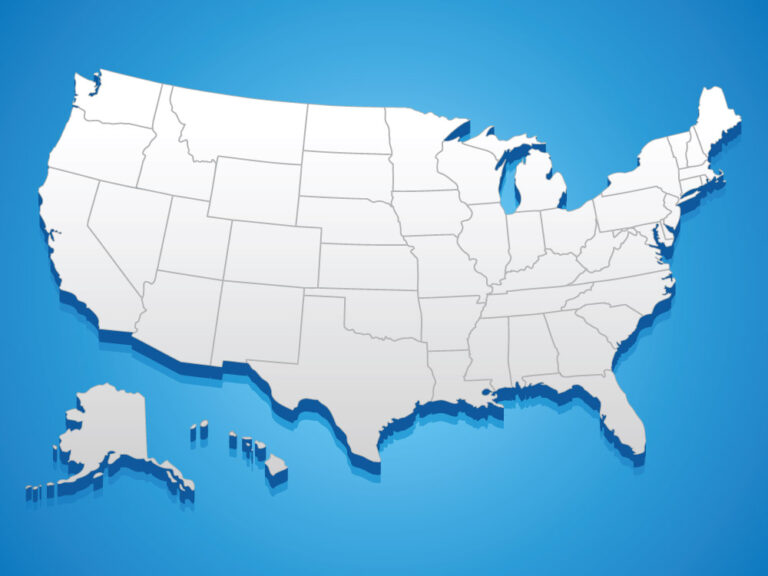Living anywhere in the United States means paying all sorts of taxes, from income tax to sales tax, and indeed, the struggle for US independence began largely because of a dispute over taxes levied on colonists by the British government. Taxes play an important role in the functioning of our society, of course, as they allow for the construction and maintenance of facilities and institutions no individual citizens could pay for on their own but which everyone needs.
Throughout the history of this country, taxes have come in different forms and have been used in different ways, and they’ve often been at the center of dramatic historical events. Even today, the types of taxes that each state levies on its citizens vary broadly, and just as society is always changing, so are the laws surrounding taxation, both at the federal and state levels.
No Taxation without Representation
In 1765, to mitigate the costs of protecting the American colonies militarily, the British parliament passed the Stamp Act, which required newspapers, permits, commercial contracts, playing cards, and various other types of legal documents to have a tax stamp on them. This stamp, of course, was only attainable through the payment of the tax. Although the amount of the tax was relatively low, colonists objected with the argument that they should not be taxed because they lacked representation in parliament.
The Boston Tea Party

The backlash and subsequent boycotts led to the repeal of the Stamp Act relatively quickly, but it also left British leaders feeling they needed to find a way to tax the colonists to demonstrate their authority. Partly because of this, they passed the Tea Act in 1773, which was an attempt to help British merchants at the expense of colonial tea smugglers and direct importers. The colonists were unhappy with this as well, and the subsequent unrest culminated in the Boston Tea Party on December 16, 1773.
In this demonstration led by the Sons of Liberty, colonists boarded ships carrying chests of tea when they arrived from Britain and threw the entire shipments into Boston Harbor. The response of the British government was harsh, and the conflict quickly escalated into what would ultimately become the Revolutionary War.
Tariffs
When the newly independent American colonies endeavored to establish a government of their own, they also needed revenue sources. At the beginning, however, tariffs on imports were the most expedient ways to raise the money the government needed to function, as its budget was relatively small, and these tariffs also encouraged the purchase of domestically-produced goods.
As the country grew, tension over tariffs began to develop between the industrializing northern states and the still heavily agricultural southern states. While high tariffs were supportive of the new industries, the southern states wanted to be able to export raw agricultural products to Europe, and so lower tariffs allowed them to do so more easily due to reciprocity agreements.
These tensions only grew over time, eventually contributing to the beginnings of the Civil War. Tariffs continued to play an important role in the financing of the federal government, however, and they were the primary source of government revenue throughout the 19th century, and even up until the beginning of World War I.
Excise Taxes
The Revolutionary War had caused a large debt to build up, and so Alexander Hamilton advocated the imposition of an excise tax on distilled beverages to help pay that back. This faced opposition as well, and eventually led to the Whiskey Rebellion in 1791. That uprising was eventually put down peacefully by the federal government, and the tax was repealed in the early 1800s.
Income Tax and the 16th Amendment
During peace time, the expenses of the federal government were manageable enough, but wars brought added costs. That led to periodic imposition of taxes on income, with the first coming in 1861 to help finance the Civil War. This was the product of the Revenue Act of 1861, which imposed a 3% tax on incomes over $800. It was replaced the following year by another Revenue Act which taxed incomes over $600 at 3% and incomes over $10,000 at 5%. These rates went up again in 1864, and the tax was repealed entirely in 1872.
The constitutionality of income taxes was often questioned, and a running debate finally led to a Supreme Court ruling in 1895 that taxing income from property was unconstitutional. This made it politically unfeasible to tax personal income from other sources, but the need for added revenue for the federal government continued.
In 1913, the 16th Amendment was ratified, and this allowed Congress to tax all types of income. The first federal income tax was adopted that same year, and it taxed incomes over $3,000 at a rate of 1%, with an increase to a 6% rate for incomes over $500,000. The top rate quickly increased to 77% on incomes over $1,000,000 by 1918 to help finance World War I.
Over time, the top rate, as well as those below and the number of income brackets in total, have all fluctuated considerably. Currently, there are seven separate income brackets, each with a different tax rate. These rates range from 10% for incomes under $9,325 for an individual or $18,650 for a couple, to 39.6% for incomes above $418,401 for an individual and $470,701 for a couple.
Other Federal Taxes and Exemptions
As the tax system expanded, many other details were added on as well. These include a myriad of deductions and exemptions for everything from mortgage interest to child care expenses to health insurance. As many people, especially at the top levels of income, began taking advantage of these measures to pay less in taxes, the Alternative Minimum Tax was instituted to ensure that everyone would still contribute adequately to the system.
Corporate taxes have also evolved over time, and there are other federal taxes including the estate tax, the payroll tax which funds Social Security and Medicare, and the capital gains tax which separates out earned interest income from other types of income to tax it at a different rate.
The Origins of Sales Tax
Revenue the federal government takes in is used to fund a wide-ranging network of public programs, as well as to maintain interstate infrastructure, public parks, and more. State governments have their own needs, however, and so they sought to establish their own revenue streams.
The earliest form of a sales tax appeared in Pennsylvania in 1821 in the form of a mercantile license tax, but that was not broad based. Kentucky was the first state to institute a tax on retailers, which went into effect in 1930. This one was progressive, but it was soon replaced by a flat 3% tax in 1934, and was then eliminated entirely in 1936.
The first straight sales tax went into effect in Mississippi in 1930, however, and many other states soon followed suit. In total, 24 states instituted some type of sales tax in the 1930s, with handfuls more adding the tax in the 1940s and 1950s. Eleven states added a sales tax in the 1960s, with Vermont the last to do so in 1969. There remain five states that do not have a broad-based state sales tax, although some of them do tax certain specific items or allow local governments to impose their own sales taxes.
Sales Tax Tokens

Because sales tax was such a small percentage of purchases, it often came out to be much less than a penny when it was first instituted in the 1930s. To avoid overcharging tax to customers on low-cost purchases, some institutions, as well as some state governments, began to issue sales tax tokens during The Great Depression. These were usually in denominations of tenths of a cent, and they were made of various materials including bronze, cardboard, pressed cotton fiber, and aluminum.
Issuing states included Colorado, Kansas, Washington, Alabama, Illinois, Louisiana, Arizona, New Mexico, Missouri, Oklahoma, Utah, and Mississippi. Several other states used variations of the concept, including sales tax stamps and fractional cent pieces, and all of these were mostly phased out by the end of the 1930s.
State Revenue Streams and Ongoing Trends
The importance of sales tax revenue to state governments is hard to overemphasize. In fact, from 1970 to 1998, sales tax contributed the largest share to state government finance. It was eventually surpassed by state income taxes, which have grown over time but are limited due to the large share already taken by the federal government.
Downturns in the economy can also have an outsized impact on how much is taken in by states through income taxes, and sales tax revenue has been shown to be much more consistent during these periods. Property tax provides another important stream of revenue for states, and it was the primary source until sales taxes began to really take off.
Sales taxes were initially imposed only on certain purchases of what is often referred to as real tangible personal property. This made sense, as these types of sales made up the bulk of the economy for most of the 20th century. However, as the economy has shifted more towards services in recent years, many states have begun to expand sales tax to cover certain types of services as well, and this trend is likely to continue moving forward.
Another major challenge for states in their attempts to bring in as much revenue as possible is the growth of internet sales, as these often ship from out-of-state. Under most state statutes, sales tax can only be collected on the purchase of an item if the seller has a significant presence, or nexus, in the state. If sales tax is not due, the purchaser is generally required to pay a use tax once the total tax due in each year exceeds some minimum amount.
This provision is rarely adhered to and nearly impossible to enforce, however, so many states are investigating the establishment of “Amazon laws” which would require sales tax to be collected and remitted on purchases delivered into their state regardless of whether the seller has a traditional nexus. This is also a trend that’s not likely to end soon, and as new technologies expand the possibilities for methods of consumption of all kinds of things, from actual physical property to entertainment, sales tax laws will continue to evolve as well.






